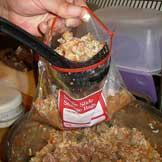
I’ve mentioned many times on Nutrition Nuggets how important it is to monitor a pet’s response to a diet when making the final determination as to whether or not a particular food is right for that individual. One of the parameters I always look for is a healthy coat.
Owners tend to focus on grooming when it comes to coat care. I’ll often hear questions like “Do I need to brush more frequently?” or “Is there a shampoo or conditioner I should be using?” While proper grooming is important, chronic problems with a dog’s coat often originate with a poor quality diet. Foods that do not supply high quality nutrition cannot promote healthy skin and fur.
Fur (or hair if you prefer) is made primarily of protein. The body tends to dole out its resources according to what has highest priority. Protein is needed to build and maintain muscle, make critical components of the immune system, form enzymes that catalyze chemical reactions in cells, and more. It shouldn’t be too surprising that one of the first signs of protein deficiency is a poor quality coat. Dogs can live if they look a little scruffy, but that may not be the case if they can’t fight off disease or run away from danger.
The minimum protein percentage that appears in a food’s guaranteed analysis is important but is not the only parameter that affects whether a dog’s needs are being met. The quality of the protein sources used to make the food is also critical. Unfortunately, ingredient quality is almost impossible to assess based on the information that is included on a dog food label.
Essential fatty acids (EFAs) are also important for the maintenance of a healthy coat. Omega 3 and omega 6 fatty acids act to moisturize the skin from the inside out, improve its ability to act as a barrier to potential allergic triggers and irritants, and give fur the shine we associate with good health.
Information about the amounts of omega 3 and omega 6 fatty acids included in a dog food does not have to be printed on the label. Therefore, it can be difficult to determine whether or not a particular diet contains the EFAs a dog needs. Ingredients that provide a lot of EFAs include some types of fish and fish oil (e.g., salmon), soybeans, soybean oil, olive oil, flaxseed, and flaxseed oil (although there is some question as to how efficiently dogs can use flaxseed products). If several of these ingredients appear in the ingredient list, there is a good chance that the manufacturer is paying attention to the EFA levels in that diet. When necessary, fatty acid supplements can be added to a dog’s diet.
If you are not impressed with the quality of your dog’s coat, try switching to a food that puts an emphasis on essential fatty acids and protein quantity and quality. You should notice an improvement within a month or so. If that’s not the case, or if your dog suffers from patchy hair loss, excessive itchiness, or skin lesions, talk to your veterinarian.

Dr. Jennifer Coates
Image: Thinkstock









